Surprising Discrepency in Inflation
Take a look at https://steemd.com
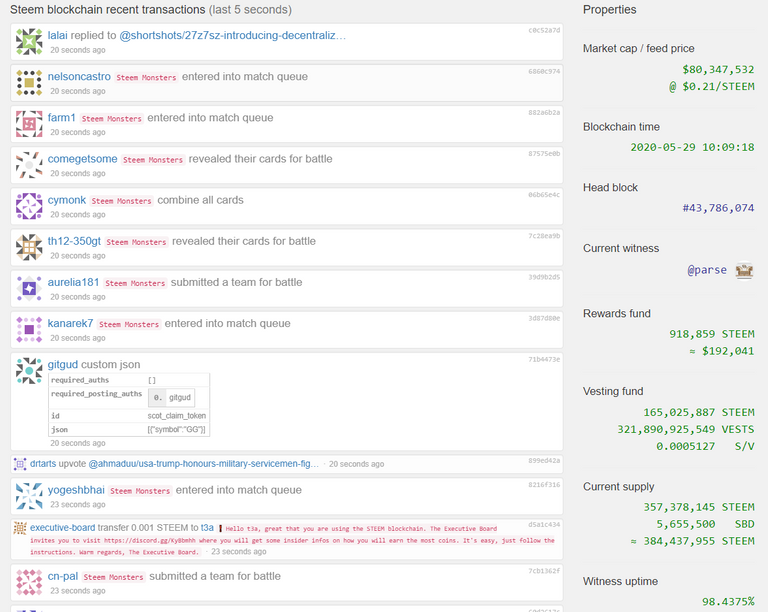
Now take a look at https://hiveblocks.com
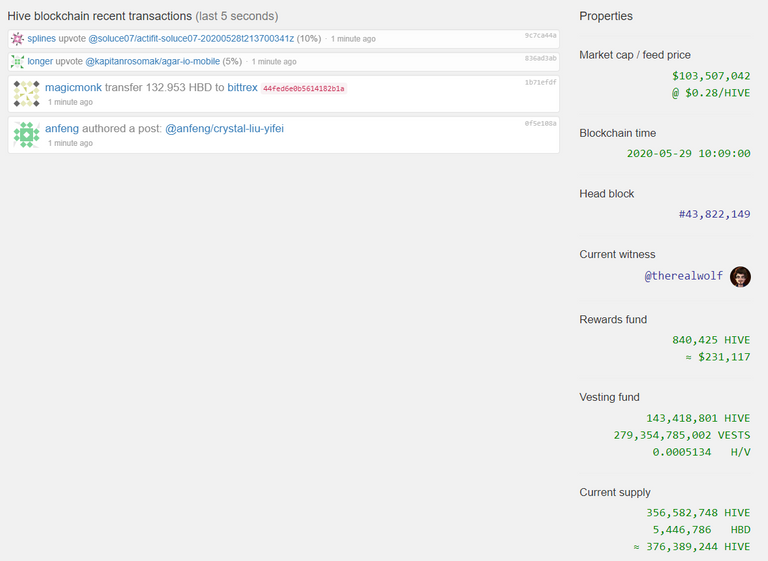
Do you notice anything peculiar or unexpected? (The title of this article should give you a clue where to look).
How about this?

There's almost 800,000 more Steem than there is Hive. There's also more SBD than HBD, and when Virtual Steem and Virtual Hive are considered, which include the virtual collateral behind SBD and HBD, there's a shocking 8 million more Steem than Hive in existence.
There has only been 10 weeks since the fork, and there have not been any prolonged outages that would explain a large difference in supply. In such a short time There has managed to be 800,000 more new Steem and 8,000,000 virtual Steem than compared to the Hive branch. Steem and Hive are supposed to be using the same issuance curve. Therefore, they should have the same inflation, right? Well no, and that is what this article seeks to explain.
Issuance and Inflation
In most cryptocurrencies, issuance and inflation are the same, and this I think is where the confusion lies. Take for example Bitcoin. Bitcoin has an issuance algorithm where every block is allowed to create a certain amount of new Bitcoin and allocate it to any address they choose. The transaction where this happens is called the "Coinbase transaction", and it is usually divided among addresses belonging to miners in a mining pool. Every 210,000 blocks, the amount the miner is allowed to reward halves, and if you draw this out on a chart, you get the issuance curve.
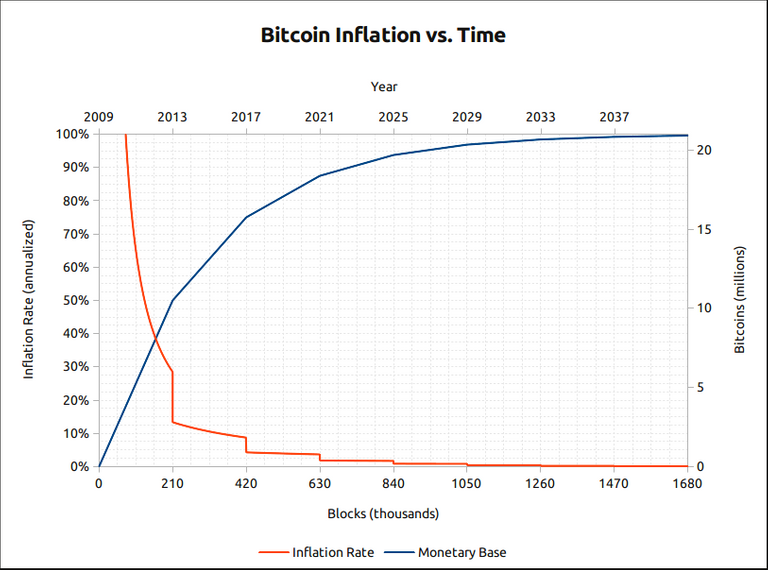
In Bitcoin this issuance is completely the same as inflation - because aside from a short 100 block delay, the coinbase transaction is spendable Bitcoin pretty much immediately.
Here is the issuance curve of Steem, post Hard Fork 16 which changed it (green line not blue line). The same issuance curve is used in Hive.
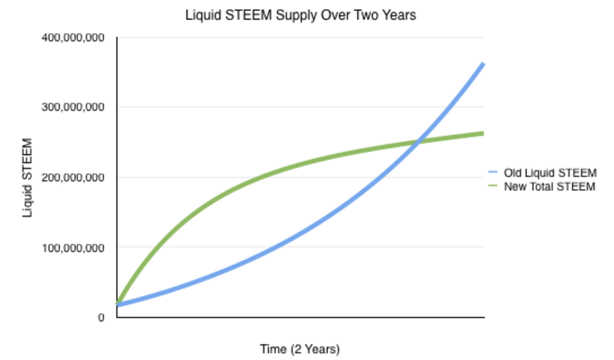
Note again, the actual supply was much higher than the chart predicted. At the end of 2018 there was 283 million Steem and 307 million Virtual Steem - millions more than the chart suggests 2 years after the fork.
Here is a chart of actual supply on Steem by @socky since he started collecting the data in mid 2018 (blue line in this chart).
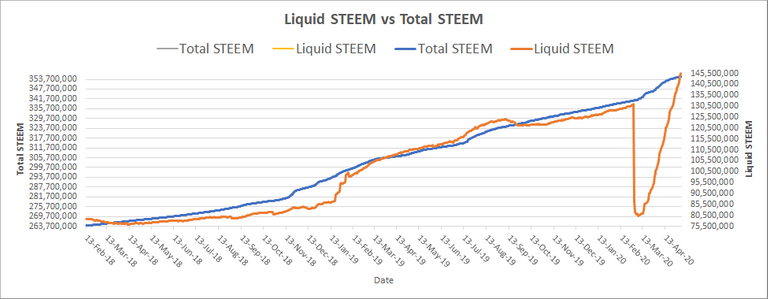
Aside from the fact that it's more than predicted, you may notice that it's not a smooth curve as is seen in Bitcoin and most other cryptos. There are periods where it rises faster than normal, the slope of the curve is not consistent, nor is it gradually declining in a smooth fashion. As noted earlier, this is due to the fact that the issuance curve is not the true inflation curve on Steem and Hive.
True Inflation
So what actually determines inflation in Steem and Hive? Well, the issuance curve is most certainly a factor. But you have to understand how issuance works in Steem and Hive to get the other important factors. Steem is not simply allocated freely to whomever the block producer decides, as in Bitcoin. The vast majority is added to the reward fund as Virtual Steem/Hive. Some is added to the vesting fund. Some is added again to the vesting fund for witnesses (with new vesting shares for the witness). And some are created as SBD/HBD for the DAO. When rewards are issued, most again are added to the vesting fund, with new vests as rewards for curators and authors. A portion get converted into SBD/HBD.
It's the SBD and HBD that are key to the difference between issuance and true inflation. SBD and HBD are created at a rate where the collateral value is decided by the price feed. Thus, new virtual Steem/Hive is created in accordance with the issuance curve. However, after that, the virtual Steem/Hive can expand or contract based on the price feed. A lower price of Steem/Hive results in the remaining SBD/HBD converting into a larger amount of Steem/Hive.
When SBD/HBD is converted at a price feed rate higher than they were created at - true inflation is reduced. It will go below the rate defined by the issuance curve. When SBD/HBD is converted at a feed price below the feed price it was created at - true inflation is increased beyond the issuance rate. So the feed price is a factor in true inflation.
SBD/HBD Conversions are not initiated by consensus. They are initiated by individuals based on a pursuit of profit. Profit is higher when the price of SBD/HBD is lower, which tends to also be when the price of Steem/Hive is lower. More conversions happen in a bear market, and for this reason, Steem/Hive inflation gets worse. There is no corresponding decrease in a bull market, because there are fewer conversions. People wait for the price of SBD/HBD to be low before converting. Indeed, more SBD and HBD are created at the higher feed price - further increasing the pressure for high inflation later.
Conclusion
The extra factors that deterimine true inflation are the feed price at conversion and the price of SBD/HBD. The reason Steem has had more inflation since the fork is because it has been more attractive to convert SBD, at a lower feed price than for HBD. There is nothing fundamentally which will bring the supplies back into alignment, as long as Steem continues to have a lower price, and as long as SBD gets converted, Steem is likely to have more inflation than Hive going forward.
There is a long term expectation that true inflation will be higher than the issuance curve for both Steem and Hive, but it may be worse for Steem.
Other factors not discussed: burning Steem/Hive with @null
The "true" measure of inflation sould be applied to the virtual supply not the current supply. Although since perception is an important driver on the markets HBD conversions introduces a certain level of undertainty on the actual supply (by this I mean the amounts that actually hit the markets).
When the debt ratio is 10% or higher the virtual supply is calculated with the formula:
Each conversion will reset the virtual supply by virtue of increasing the current supply until it reaches a point of equilibrium (when there is enough virtual supply to support the peg for HBD).
Since there is no codeded mechanism in place to stop the DAO from printing HBD we can logically conclude that the tendency will always be to reach the 10% ceiling for the debt ratio and therefore for the virtual supply to get to it's limit in the long run.
In the short existence of HIVE the evolution of the virtual supply has been pretty interesting:
Having said that, the existence of HBD in it's current form is to much of a wildcard and we should fix it. Instead of having a floating value of HIVE sustain the peg I believe that we should have a hard limit set by the amount on the DAO and remove it from the reward pool.
Otherwise we need use-cases that burn or lockup HIVE and/or HBD at a high rate.
Note: if you look at the graph you can see a spike in the supply in the last few days driven by the dumping of HBD on the Upbit market (right after they opened the pairs for trading). It wasn't driven by the debt ratio getting to it's limit but by korean holders just dumping their holdings.
You can't sell a virtual Steem on the market (at least not as STEEM) so I don't consider it realized inflation, but this is getting into pure semantics.
The potential virtual supply is ultimately unlimited, because it is increased every time a conversion is completed. The 10% ratio which triggers a haircut limit only acts to slow down such a potential expansion of supply to ultimately any amount. All you have to do is split the HBD into multiple convert transactions and you would easily, vastly exceed the 10% limit (assuming you're already at it). The Koreans dumping on UpBit did not increase the virtual supply, rather they made it attractive to people who used the convert contract on a large scale, and that increased the supply of Hive, increasing the "potential virtual hive" by the 10% rule.
In practical terms the potential virtual supply is not unlimited. The limit is the HBD supply, if all of it is converted there is no way to increase the virtual supply and therefore the current supply via that method.
Of course the dumping on Upbit did not increase the supply but rather it replicated a situation where the debt ratio exceeds the 10% limit and brakes the peg making it profitable to play the arbitrage game of buying HBD with the intent to convert.
I certainly do not disagree with any of your points. It is as clear as day that the existance of HBD introduces a volatile factor that determines the evolution of the HIVE supply outside of what is programatically set to happen.
the real question is when steem's price will start to get the downfall
Another factor that influences at least the perceived inflation rate is variations in the percentage of Steem/Hive that is vested vs. liquid:
https://peakd.com/hive-174578/@preparedwombat/the-hive-power-you-earn-for-holding-hive-power
Granted, that’s the rate of return on vested tokens rather than the creation of tokens.
That's a good point. We can break total inflation down into liquid inflation, circulating supply etc. Liquid inflation can be enormous when an exchange is powering down.
Good and clarifying analysis
A very informative article, should be essential reading for all!
@tipu curate
Upvoted 👌 (Mana: 0/6)
I have problem understanding, how inflation is relevant on a deflationary cryptocurrency? As you can see, the value of an actual free-market token does not come from the numerical value of supply.
The more people use it, the more versatile it gets, the more the actual value is. BTC for example is good for sending numbers anywhere in the world, where Western Union used to rip people off.
Hive is also a highly advanced social media platform, which has the potential to become a global new economy. Technology advances in waves, the first ones cathing the peak can surf the longest.
Price is a function of both supply and demand. I agree overall demand is more important. But people should be aware of supply as well, and have an accurate expectation of how supply will increase.
Also, Steem and Hive are not deflationary. They will tend towards lower inflation over time, but eventually a stable issuance (where a deflationary currency would go to 0 issuance and net negative when issuance is less than lost coins per year).
Around 99,9% of people don't even know how euros are created, so on cryptos inflation is even smaller issue. Since the motive is to hodl, we are talking about deflation, right?
I tend to ask people these questions and the last answer is usually "economics". Cannot tell, what it means in practice.
Interesting, if all being equal, the Hive inflation would be ahead since its block height is higher. Steem got a bit slow there.
Hadn't thought about the conversions.
Thanks for this. Very clear, even for me.
Just need to test ;):
!ENGAGE 1
exciting :D
Should be a fail? I need to check what I asked...
edit: not a fail :)
There was still a typo in my code...
!ENGAGE 1
!ENGAGE 100
ENGAGEtokens.Fist try did not work, as it seems. Fixed the code:
!ENGAGE 1
ENGAGEtokens from abh12345ENGAGEtokens from abh12345